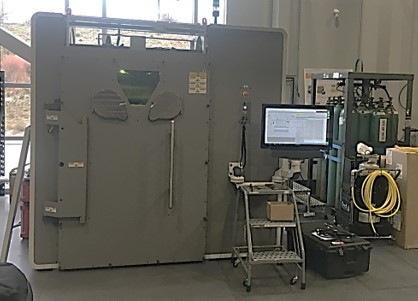Our AM&AM Lab has two commercial, high-performance, and fully enclosed metal printers. The collaboration with Greenville Technical College also provides us with unique facilities. Clemson University also has several state-of-the-art experimental and computational facilities necessary for conducting research in my team. Please find the detailed descriptions for these facilities below.
OPTOMEC LENS MR-7 Metal Printer (in Professor Liu’s Lab)
This system has a laser-directed energy deposition (L-DED) working principle. It utilizes a high-power laser together with powdered metals to build fully dense structures directly from a 3-dimensional CAD solid model. The CAD model is automatically sliced into a tool path, which instructs the LENS machine on how to build the part layer by layer. The printing process is housed in a chamber that is purged with a circulatory argon system such that the oxygen level continuously stays below 10 parts per million to ensure no impurity pick-up during deposition. The 1000 W continuous-wave fiber laser and 660 µm focal spot size are beneficial for processing high melting-point and reactive metals. The metal powder is fed to the process by OPTOMEC’s proprietary powder-feed system, which is able to flow small quantities of powder very precisely. When complete, the unused powders can be recycled easily. The two powder hoppers are programmable to feed different species of powders synchronously or asynchronously, making the system especially suitable for in-situ synthesis of multi-component metal and metal-based advanced materials. Additionally, the 300 mm cubed build volume makes it ideal for high throughput fabrication and repair/remanufacturing.
3D SYSTEMS DMP Flex 350 Metal Printer (in Professor Liu’s Lab)
This system has a laser-powder bed fusion (L-PBF) working principle. It is designed for flexible application use for R&D projects, application development, or serial production. Metal additive manufacturing software 3DXpert is the industry’s most powerful tool to prepare and optimize part data quickly, enabling rapid design for metal additive manufacturing to shorten production time and increase part precision. The laser power is 500 W, the focal spot size is 80 µm, and the scan speed is up to 10 m/s. The smallest printable feature size is about 100 µm. The 425 mm × 275 mm × 275 mm closed-vacuum-chamber design can maximize powder reuse, prevent argon-gas bubbles from permeating the part, and control the oxygen level below 10 parts per million during printing, which is also applicable to reactive materials such as aluminum and titanium alloys. The high power density, high resolution, and large build volume make it ideal for the scalable design of complex components. By adjusting the laser energy density via changing the processing parameters, this printer can achieve “melting” or “sintering” functions, which provides more capabilities for structure design and material fabrication.
Renishaw AM400 Metal Printer (Greenville Technical College Facility)
This system is accessible to Professor Liu’s research team. It is located at Greenville Technical College—Center for Manufacturing Innovation. It has a laser-powder bed fusion (L-PBF) working principle. The system is equipped with a 400 W pulsed laser and has a 70 µm focal spot size at the powder bed. In the pulsed laser mode, the laser beam is operated using the point exposures instead of running continuously. It helps generate discrete melt pools and even higher cooling rates than the continuous laser mode. While the peak scan speed is 2 m/s, the printing efficiency is high due to the pulsed laser mode. The build volume is about 250 mm × 250 mm × 300 mm. It has been designed for users who require the flexibility to change between different materials, with a range of accessories being available to minimize the risks of cross-contamination. More information about this printer can be found at https://cmigreenville.com/additiveserv.html.
Powder Room (Greenville Technical College Facility)
This unique and beneficial powder handling room is accessible to Professor Liu’s research team. This room is used to store, sieve, process, and prepare various feedstock materials for metal additive manufacturing (AM) processes. The room is fully ventilated and spark-proof. There are two automatic sieving systems to sieve powder materials for L-PBF printers. Professor Liu drafted safety and operable manuals for powder material processing, which are visible to personnel working in the room. This room ensures a clean and safe working environment necessary for AM feedstock material processing.
Clemson University Advanced Materials Research Laboratory (AMRL)
The Clemson University Advanced Materials Research Laboratory (AMRL) is an innovative campus and technology park located in Anderson, South Carolina. It is a state-of-the-art facility that houses internationally recognized research programs in optoelectronics, chemistry, and materials science. It also houses one of the nation’s most outstanding electron microscopy facilities and a professional staff that provides services to private industry and academic clients. Many electron microscopy facilities such as SEM, TEM, EBSD, EDX, XRD, and FIB play a key role in Professor Liu’s research.
Clemson Palmetto High Performance Computing (HPC) Cluster
Clemson’s Palmetto Cluster empowers the University research community with vital resources for innovation (https://www.palmetto.clemson.edu/palmetto/). This infrastructure integrates world-class provisions in high-performance computing, high-performance networks, data visualization, storage architectures and middleware. All Clemson researchers can use and receive training on the Palmetto Cluster for free. Currently, Palmetto is comprised of 1786 compute nodes (totaling 34916 CPU cores), and features:
- 1786 compute nodes, totaling 34916 cores
- over 850 nodes are equipped with 2x NVIDIA Tesla GPUs (K20, K40, P100, V100 and A100)
- 15 large-memory nodes with 0.75 TB – 1.5 TB of memory)
- 100 GB home directory space for each user
- 2.2 PB of scratch storage space
- 10 and 25 Gbps Ethernet, and 56 and 100 Gbps Infiniband networks
- benchmarked at 3.0 PFlops
- the cluster is 100% battery-backed




